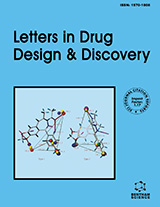Abstract
Introduction: A novel series of multifunctional anti-Alzheimer’s agents based on Nsubstituted aryl sulphonamides were designed and synthesized. During in vivo moderate to good anti- Alzheimer’s Disease (AD) activity was observed as correlated by the modulation of some selected biochemical markers of AD as well as during behavioral assessment.
Methods: Among the series, some compounds have shown multi-functional potency by inhibition of Acetylcholinesterase (AChE), Scopolamine induced oxidative stress and were found comparable to the standard drug. Successful modulation of biochemical markers of oxidative stress in AD, displays neuroprotective properties and did not exert any significant toxicity.
Results and Conclusion: Thus, the present study has evidently shown that these series of compounds have potential to be optimized as anti-AD agents with multi-functional properties. The aryl sulphonamide nucleus might serve as a promising lead candidate for developing novel anti-AD drug.
Keywords: Alzheimer`s disease, behavioral assessment, oxidative stress, Acetylcholinesterase (AChE), inhibition, histopathology.
Graphical Abstract
Current Computer-Aided Drug Design
Title:N-Substituted Aryl Sulphonamides as Potential Anti-Alzheimer’s Agents: Design, Synthesis and Biological Evaluation
Volume: 14 Issue: 4
Author(s): Neeraj Masand*, Satya P. Gupta and Ratan Lal Khosa
Affiliation:
- Department of Pharmacy, Lala Lajpat Rai Memorial Medical College, Meerut, Uttar Pradesh,India
Keywords: Alzheimer`s disease, behavioral assessment, oxidative stress, Acetylcholinesterase (AChE), inhibition, histopathology.
Abstract: Introduction: A novel series of multifunctional anti-Alzheimer’s agents based on Nsubstituted aryl sulphonamides were designed and synthesized. During in vivo moderate to good anti- Alzheimer’s Disease (AD) activity was observed as correlated by the modulation of some selected biochemical markers of AD as well as during behavioral assessment.
Methods: Among the series, some compounds have shown multi-functional potency by inhibition of Acetylcholinesterase (AChE), Scopolamine induced oxidative stress and were found comparable to the standard drug. Successful modulation of biochemical markers of oxidative stress in AD, displays neuroprotective properties and did not exert any significant toxicity.
Results and Conclusion: Thus, the present study has evidently shown that these series of compounds have potential to be optimized as anti-AD agents with multi-functional properties. The aryl sulphonamide nucleus might serve as a promising lead candidate for developing novel anti-AD drug.
Export Options
About this article
Cite this article as:
Masand Neeraj *, Gupta P. Satya and Khosa Lal Ratan , N-Substituted Aryl Sulphonamides as Potential Anti-Alzheimer’s Agents: Design, Synthesis and Biological Evaluation, Current Computer-Aided Drug Design 2018; 14 (4) . https://dx.doi.org/10.2174/1573409914666180604115425
| DOI https://dx.doi.org/10.2174/1573409914666180604115425 |
Print ISSN 1573-4099 |
| Publisher Name Bentham Science Publisher |
Online ISSN 1875-6697 |
 29
29 2
2
- Author Guidelines
- Bentham Author Support Services (BASS)
- Graphical Abstracts
- Fabricating and Stating False Information
- Research Misconduct
- Post Publication Discussions and Corrections
- Publishing Ethics and Rectitude
- Increase Visibility of Your Article
- Archiving Policies
- Peer Review Workflow
- Order Your Article Before Print
- Promote Your Article
- Manuscript Transfer Facility
- Editorial Policies
- Allegations from Whistleblowers
Related Articles
-
Multiple Roles for Glycogen Synthase Kinase-3 as a Drug Target in Alzheimers Disease
Current Drug Targets Glial Reaction in Parkinsons Diseases: Inflammatory Activation Signaling of Glia as a Potential Therapeutic Target
Current Signal Transduction Therapy Immune-Neuroendocrine Interactions Involving Thymus and Pineal Gland in Stem Cell Therapy of Age-Related Diseases
Immunology, Endocrine & Metabolic Agents in Medicinal Chemistry (Discontinued) Paediatric Antiretroviral Drug Targets
Infectious Disorders - Drug Targets Gliogenesis and Glial Pathology in Depression
CNS & Neurological Disorders - Drug Targets Curcumin: Structure-Activity Relationship Towards its Role as a Versatile Multi-Targeted Therapeutics
Mini-Reviews in Organic Chemistry Neuroproteomics: Are We Biased in Our Representation of Molecular Targets Associated with Specific Domains? Implications in Biomarker Discovery
Current Proteomics Circular RNAs in Eukaryotic Cells
Current Genomics Atherogenic Versus Non-atherogenic Lipoprotein Profiles in Healthy Individuals. Is There a Need to Change Our Approach to Diagnosing Dyslipidemia?
Current Medicinal Chemistry Brain Perfusion In Sepsis
Current Vascular Pharmacology Persistent Psychosis from Toluene Exposure; More Likely Coincidence than Cause: A Review of our Experience and the Literature
Current Psychiatry Reviews Cardiac Dys-Synchronization and Arrhythmia in Hyperhomocysteinemia
Current Neurovascular Research Alzheimers Disease, Ceramide, Visfatin and NAD
CNS & Neurological Disorders - Drug Targets Decline of Executive Processes Affects the Identification of Emotional Facial Expressions in Aging
Current Aging Science Computational Models of Neuronal Biophysics and the Characterization of Potential Neuropharmacological Targets
Current Medicinal Chemistry Neurofibrillary Tangles and Senile Plaques in Alzheimers Brains are Associated with Reduced Capillary Expression of Vascular Endothelial Growth Factor and Endothelial Nitric Oxide Synthase
Current Neurovascular Research Intracerebrally Applied Botulinum Neurotoxin in Experimental Neuroscience
Current Pharmaceutical Biotechnology Tubulin-Independent Tau in Alzheimer’s Disease and Cancer: Implications for Disease Pathogenesis and Treatment
Current Alzheimer Research Autoimmunity in Alzheimers Disease as Evidenced by Plasma Immunoreactivity Against RAGE and Aβ42: Complication of Diabetes
Current Alzheimer Research Dysregulated NF-κB Pathway in Peripheral Mononuclear Cells of Alzheimers Disease Patients
Current Alzheimer Research


























